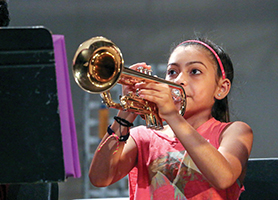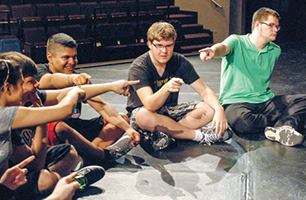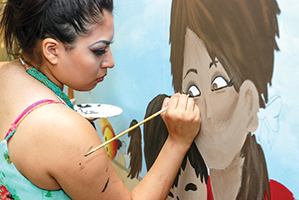
The Assessment Landscape in Arts Education
Newly adopted standards provide a roadmap for instruction in dance, music, media arts, theatre and visual arts
By F. Robert Sabol/
School Administrator, December 2015
When I started teaching art at the elementary level about 35 years ago, student assessment rarely was done or even much of an issue. As a traveling teacher, I taught art in six elementary schools of a district in Crawfordsville, Ind.

|
Assessment standards developed by the National Consortium for Core Arts
Standards will be piloted in the various disciplines in the spring with
examples of student work being shared subsequently. (Photo courtesy of High School District 214, Arlington Heights, Ill.)
|
I had more than 1,800 students and saw them for about 45 minutes every three weeks, so opportunities to assess the students in class were limited. Helping the elementary classroom teachers know how students were performing so they could place a plus, check or minus sign on report cards was about as far as assessment went in those days.
Assessment today has become a prominent feature on the landscape of quality education in the arts. Arts educators embrace assessment as a tool to illustrate the scope and rigor included in learning in the arts, as well as being a means for demonstrating student achievement and growth over time. Educators routinely use assessment results to expand and improve the curriculum, instruction and learning. Arts educators have worked harder in recent years to create and implement meaningful assessments for their programs and schools.
Getting Our Bearings
During the 1980s, standards-based education sprang up across the nation, leading to the development of state and national curriculum standards in all disciplines. In 1994, national arts standards were published by the American Alliance for Theatre and Education, the National Association for Music Education (then known as the Music Educators National Conference), the National Art Education Association and the National Dance Association. Forty-eight states adopted those standards for use in their schools, while others adapted or modeled their state or local arts standards after the national standards.
The standards provided arts educators with common categories of content knowledge and skills that people who are literate in the arts must learn. Findings from studies I conducted in 1998, 1999, 2001 and 2010 of urban, rural and beginning art teachers revealed student learning in the arts improved significantly because a standards-based arts curriculum provided a more comprehensive and sequential approach to learning in the arts.
 |
Robert Sabol says new learning standards for theater, as well as media
arts and music, include discipline-specific expectations dealing with
artistic processes of creating, responding and presenting. (Photo courtesy of High School District 214, Arlington Heights, Ill.)
|
In recent years, it became clear new national standards in the arts were needed to keep pace with the changing field of general education. This led to the formation in 2010 of the National Consortium for Core Arts Standards, consisting of professional arts education associations and other arts education-based organizations interested in jointly writing new national arts standards. The new standards (
www.nationalartsstandards.org), released in fall 2014, were based on the principles of the Understanding by Design model devised by Grant Wiggins and Jay McTighe. The process took five years and involved thousands of arts educators who served as writing team members and reviewers.
New standards were created for dance, media arts, music, theatre and visual arts. These standards include discipline-specific and grade-level standards that are focused on the artistic processes of creating, responding, presenting and connecting.
The previous standards contained a singular focus on understanding content knowledge and skills. The new standards are unique in that they not only include content knowledge and skills, but also include enduring understandings and essential questions. These enable students to clearly understand what they should learn in the arts, but also, and more importantly, why they should learn the content included in each of the artistic processes. The standards enable students to better understand how the arts impact the quality of daily life for all human beings and how the arts enable us to communicate with others across time, culture and space.
A New Model
 |
A Vanguard School student paints a mural inside the administration
center in Arlington Heights, Ill., as part of an alternative education
program. (Photo courtesy of High School District 214, Arlington Heights, Ill.)
|
A critical decision the National Consortium for Core Arts Standards made early in the standards developmental process was to include examples or models of assessments that were based on the new arts standards. These are known as Model Cornerstone Assessments, and they can be used as intact assessments by educators or modified to meet state or local needs, resources or requirements.
The development teams that wrote the model included arts educators with assessment knowledge. The Model Cornerstone Assessments were written for 2nd, 5th and 8th grades and included proficient, accomplished and advanced assessments for the secondary school level.
Following their publication along with the new standards, groups of arts educators from each discipline piloted the assessments with students in the three grade levels. The pilot, funded by the National Endowment for the Arts, was conducted in spring 2015, and assessment results were benchmarked during the past summer. Portfolios of student work judged as having met the standards for each cornerstone will be published by the end of 2015 on the NCCAS website (
www.nationalartsstandards.org). The assessment standards for use at the secondary level will be piloted in the spring with examples of student work posted late in 2016.
Rough Terrain
Arts education programs have unique assessment challenges. Often teachers in arts programs are responsible for a heavy student load. Managing the sheer volume of assessment data that represent the varying knowledge and skills included in these programs can be problematic, and instructional time is consumed by conducting the assessments. Digital technology has improved data storage, but some arts educators lack access to the technology. Reviewing and evaluating the mass of information from each student, while identifying individual growth and learning needs, is a complex undertaking.
The most meaningful measures of learning in the arts depend on generating authentic assessments. These assessments must reflect the knowledge, skills and processes used by artists in the field. Because of the vast array of knowledge and the wide range of skills students learn over time, measuring a representative sample of such learning is a significant challenge.
Learning in the arts is cumulative. Students who have had arts classes develop a foundation for building achievement in the arts. However, in some cases, students come to programs lacking knowledge and skills. These students present special assessment challenges for arts educators.
Most assessment is conducted as an isolated activity and may not be an instructional activity. Assessments in the arts need to be embedded in the curriculum and should not be externally imposed. They also must be recurring across grade levels and they must become increasingly complex and sophisticated to capture the spiraling nature of learning in the arts.
Additionally, assessment in the arts must be adapted for use with special-needs learners. The use of equipment in arts learning also may pose safety concerns for students with disabilities.
Teachers can engage with students through formative assessment, though the heavy student loads in the arts can make it hard to present timely and meaningful feedback to students. Development of formative assessment tools, techniques and rubrics lend to the dizzying array of decisions, but through arts assessment training for educators, the landscape will be made richer and more vibrant.
Robert Sabol is a professor of art and design at Purdue University in West Lafayette, Ind. E-mail:
bobsabol@purdue.edu